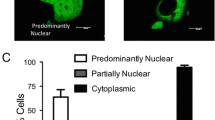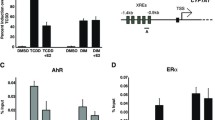Abstract
Purpose: Phenylacetate (PA) and its derivatives constitute a group of small aromatic fatty acids that have been of considerable interest due to their anticancer properties in a number of experimental systems. We previously showed that PA can inhibit the growth of estrogen receptor (ER)+ breast cancer cells and that this activity is, at least in part, mediated by the ability of the compound to inhibit transcriptional activation driven by estrogen response elements (EREs). We now shed additional light on the antiestrogenic action of PA by determining its effects on early events in the estrogen-signaling pathway. Methods: MCF-7 breast cancer cells were used in this study. ER–ERE binding activity, and subsequent effects on ER and progesterone receptors (PR), c-myc, and the cyclin-dependent kinase inhibitor p21ASF1/CP1/MDA-6 (p21) were evaluated using electrophoretic mobility shift assays, real-time RT-PCR, and western blotting methodologies. Effects of PA on p21 promoter activity were assessed in transient transfection experiments utilizing p21 promoter–reporter gene constructs. Results: We demonstrate that PA treatment can block ER–ERE binding activity and that this effect is accompanied by downregulation of PR and c-myc, two genes which are transcriptionally regulated by estrogen through novel-ER-binding sites. Suppression of c-myc by PA is followed by increased mRNA levels of p21, an effect that is mediated by PA activation of the p21 promoter. Forced overexpression of c-myc through co-transfection of MCF-7 cells with a c-myc expression plasmid prevented PA upregulation of p21 promoter activity. Conclusions: These findings confirm the potent antiestrogenic properties of PA, indicate that its effects are mediated by inhibiting ER–ERE interactions, and suggest that downregulation of c-myc is an early event leading to increased p21 expression and cell growth inhibition.






Similar content being viewed by others
References
Adam L, Crepin M, Savin C, Israel L (1995) Sodium phenylacetate induces growth inhibition and bcl-2 downregulation and apoptosis in MCF7 ras cells in vitro and in nude mice. Cancer Res 55:5156–5160
Altucci L, Addeo R, Cicatiello L, Dauvois S, Parker MG, Truss M, Beato M, Sica V, Bresciani F, Weisz A (1996) 17beta-Estradiol induces cyclin D1 gene transcription, p36D1–p34cdk4 complex activation and p105Rb phosphorylation during mitogenic stimulation of G(1)-arrested human breast cancer cells. Oncogene 12:2315–2324
Bindal RD, Katzenellenbogen JA (1988) Bis(4-hydroxyphenyl)[2-(phenoxysulfonyl)phenyl]methane: isolation and structure elucidation of a novel estrogen from commercial preparations of phenol red (phenolsulfonphthalein). J Med Chem 31:1978–1983
Claassen GF, Hann SR (2000) A role for transcriptional repression of p21CIP1 by c-Myc in overcoming transforming growth factor beta-induced cell-cycle arrest. Proc Natl Acad Sci USA 97:9498–9503
Coller HA, Grandori C, Tamayo P, Colbert T, Lander ES, Eisenman RN, Golub TR (2000) Expression analysis with oligonucleotide microarrays reveals that MYC regulates genes involved in growth, cell cycle, signaling, and adhesion. Proc Natl Acad Sci USA 97:3260–3265
Dai J, Punchihewa C, Mistry P, Ooi AT, Yang D (2004) Novel DNA bis-intercalation by MLN944, a potent clinical bisphenazine anticancer drug. J Biol Chem 279:46096–46103
Davis T, Kennedy C, Chiew YE, Clarke CL, deFazio A (2000) Histone deacetylase inhibitors decrease proliferation and modulate cell cycle gene expression in normal mammary epithelial cells. Clin Cancer Res 6:4334–4342
Devleeschouwer N, Legros N, Olea-Serrano N, Paridaens R, Leclercq G (1987) Estrogen conjugates and serum factors mediating the estrogenic trophic effect on MCF-7 cell growth. Cancer Res 47:5883–5887
Dignam JD, Lebovitz RM, Roeder RG (1983) Accurate transcription initiation by RNA polymerase II in a soluble extract from isolated mammalian nuclei. Nucleic Acids Res 11:1475–1489
Dubik D, Shiu RPC (1992) Mechanism of estrogen activation of c-myc oncogene expression. Oncogene 7:1587–1594
Gartel AL, Ye X, Goufman E, Shianov P, Hay N, Najmabadi F, Tyner AL (2002) Myc represses the p21(WAF1/CIP1) promoter and interacts with Sp1/Sp3. Proc Natl Acad Sci USA 98:4510–4515
Gorospe M, Shack S, Guyton KZ, Samid D, Holbrook NJ (1996) Up-regulation and functional role of p21Waf1/Cip1 during growth arrest of human breast carcinoma MCF-7 cells by phenylacetate. Cell Growth Differ 7:1609–1615
Han S, Sidell N (2003) RU486-induced growth inhibition of human endometrial cells involves the nuclear factor-κB signaling pathway. J Clin Endocrinol Metab 88:713–719
Han S, Sidell N, Fisher PB, Roman J (2004) Up-regulation of p21 gene expression by peroxisome proliferator-activated receptor gamma in human lung carcinoma cells. Clin Cancer Res 10:1911–1919
Hudgins WR, Shack S, Myers CE, Samid D (1995) Cytostatic activity of phenylacetate and derivatives against tumor cells: correlation with lipophilicity and inhibition of protein prenylation. Biochem Pharmacol 50:1273–1279
Johnson DE, Ochleng J, Evans SL (1996) Phenylacetic acid halides inhibit estrogen receptor (ER)-positive MCF-7 cells, but not ER-negative human breast cancer cells or normal breast epithelial cells. Anticancer Drugs 7:288–292
Loven MA, Wood JR, Nardulli AM (2001) Interaction of estrogen receptors α and β with estrogen response elements. Mol Cell Endocrinol 181:151–163
Mitchell KO, El-Deiry WS (1999) Overexpression of c-Myc inhibits p21WAF1/CIP1 expression and induces S-phase entry in 12-O-tetradecanoylphorbol-13-acetate (TPA)-sensitive human cancer cells. Cell Growth Differ 10:223–230
Nichols KE, Weinberg JB (1989) Essential amino acid deprivation induces monocytic differentiation of the human HL-60 myeloid leukemia cell line. Blood 73:1298–1306
Peters G (1994) The D-type cyclins and their role in tumorigenesis. J Cell Sci Suppl 18:89–96
Petridou A, Mougios V, Sagredos A (2003) Supplementation with CLA: isomer incorporation into serum lipids and effect on body fat of women. Lipids 38:805–811
Petz LN, Nardulli AM (2000) Sp1 binding sites and an estrogen response element half-site are involved in regulation of the human progesterone receptor A promoter. Mol Endocrinol 14:972–985
Petz LN, Ziegler YS, Loven MA, Nardulli AM (2002) Estrogen receptor α and activating protein-1 mediate estrogen responsiveness of the progesterone receptor gene in MCF-7 breast cancer cells. Endocrinology 143:4583–4591
Samid D, Shack S, Sherman LT (1992) Phenylacetate: a novel nontoxic inducer of tumor cell differentiation. Cancer Res 52:1988–1992
Samid D, Ram Z, Hudgins WR, Chack S, Liu L, Walbridge S, Oldfield EH, Myers CE (1994) Selective activity of phenylacetate against malignant gliomas: resemblance to fetal brain damage in phenylketonuria. Cancer Res 54:891–895
Samid D, Wells M, Greene ME, Shen W, Palmer CN, Thibault A (2000) Peroxisome proliferator-activated receptor γ as a novel target in cancer therapy: binding and activation by an aromatic fatty acid with clinical antitumor activity. Clin Cancer Res 6:933–941
Sawatsri S, Samid D, Malkapuram S, Sidell N (2001) Inhibition of estrogen-dependent breast cell responses with phenylacetate. Int J Cancer 93:687–692
Sidell N, Wada R, Han G, Chang B, Shack S, Moore T, Samid D (1995) Phenylacetate synergizes with retinoic acid in inducing the differentiation of human neuroblastoma cells. Int J Cancer 60:507–514
Sidell N, Pasquali M, Malkapuram S, Barua AB, Wanichkul T, Wada RK (2003) In vitro and in vivo effects of easily administered, low-toxic retinoid and phenylacetate compounds on human neuroblastoma cells. Br J Cancer 89:412–419
Sidell N, Tanmahasamut P, Ewing DE, Hendry LB (2005) Transcriptional inhibition of the estrogen response element by antiestrogenic piperidinediones correlates with intercalation into DNA measured by energy calculations. J Steroid Biochem Mol Biol 96:335–345
Sutherland RL, Hamilton JA, Sweeney KJE, Watts CKW, Musgrove EA (1995) Expression and regulation of cyclin genes in breast cancer. Acta Oncol 34:651–656
Walls R, Thibault A, Liu L, Wood C, Kozlowski JM, Figg WD, Sampson ML, Elin RJ, Samid D (1996) The differentiating agent phenylacetate increases prostate-specific antigen production by prostate cancer cells. Prostate 29:177–182
Wang MM, Traystman RJ, Hurn PD, Liu T (2004) Non-classical regulation of estrogen receptor-alpha by ICI 182,780. J Steroid Biochem Mol Biol 92:51–62
Xiong Y, Connolly T, Futcher B, Beach D (1991) Human D-type cyclin. Cell 65:691–699
Acknowledgment
This work was supported by National Institutes of Health grant CA85589.
Author information
Authors and Affiliations
Corresponding author
Additional information
Jingbo Liu and Jing Li have contributed equally to this work.
Rights and permissions
About this article
Cite this article
Liu, J., Li, J. & Sidell, N. Modulation by phenylacetate of early estrogen-mediated events in MCF-7 breast cancer cells. Cancer Chemother Pharmacol 59, 217–225 (2007). https://doi.org/10.1007/s00280-006-0260-3
Received:
Accepted:
Published:
Issue Date:
DOI: https://doi.org/10.1007/s00280-006-0260-3




